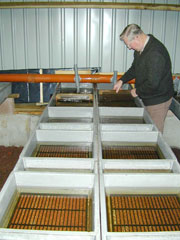
 |
|||||
| Restoration Project ~ Provision of a Hatchery | |||||||||||||||
|
THE DEE SALMON ASSOCIATION / DDSFB HATCHERY it will be able to hold up to 300,000 ova in the 10 hatching troughs with the potential tank space to ongrow these ova to fry and parr as required. |
 |
||||||||||||||
 |
The timing of the hatchery could not be more opportune as stocks of Dee salmon continue to remain dangerously low despite continuing improvements in water quality and in-stream habitats on numerous feeder streams in the catchment. The many miles of un-populated stream habitat will be ideal for stocking out eyed ova and salmon fry/parr to boost the flagging natural stocks. This first year the hatchery is on a trial run with a limited stock of around 30,000 ova sourced from the Dee and Tarf. This allows us to ensure all the small problems can be ironed out before committing to full operating levels next year. The ova are doing well despite some very cold temperatures over Christmas and early spring, they are at the eyed stage and over the next few weeks as temperatures rise we should see them hatching. |
||||||||||||||
| HOW THE HATCHERY OPERATES In late autumn to early winter we obtain our broodstock ( adult salmon ) from the fish ladder at Tongland dam, electrofishing sites on the rivers Dee and Tarf and from kind donations from rod and line anglers. The broodstock are transported to the hatchery and held in the circular tanks until they are ready to spawn. Once ripe the hen and cock fish are manually stripped to obtain the eggs and milt. These are mixed, washed, measured and then laid out in the hatching troughs. The stripped fish are carefully revived and then released below the dam system. |
 |
||||||||||||||
 |
Under the cover of darkness (mimicking the gravel beds in nature) the ova develop from the very delicate green eggs to the more robust eyed egg stage through the winter ( If necessary or desirable the eyed ova can be stocked out into the streams in man made redds, which has proved very successful) . Any dead eggs are carefully removed from the troughs to prevent fungal infections and under good conditions a survival rate between 80 – 99% can be expected up to the point of hatching. |
||||||||||||||
| At hatch the tiny alevins are very fragile and need to be carefully watched until they absorb their yolk sac and start to look for food as swim up fry, at this point they finally resemble small fish and can start to be stocked out in the Dee catchment. The hatchery has the ability to grow these tiny fry on in its circular holding tanks to any stage desired. The decision as to what stage they will be stocked out depends on the amount of room in the hatchery, the amount of water available to grow them on in, the different water bodies they will be stocked into and the levels of manpower to undertake the labour of stocking out. In some cases stocking out eyed ova is highly desirable especially when the hatchery has lots of eggs so needs the load reduced, there are streams with little or no existing stock to disturb or compete with or you have limited manpower and want to empty the hatchery as soon as possible. |
 |
||||||||||||||
 |
Often leaving the rearing of these wild animals to ‘mother nature’ is the best start they can have, getting used to their environment from the beginning, learning to feed on invertebrates and not fish food and having no mollycoddling allows them to become robust juveniles. In some cases it is not possible to stock the eggs out as the streams may be slightly too acidic for eggs to hatch but not too acidic for small fish to survive in or too silted and have unsuitable substrates for eggs but still be reasonable habitats for juveniles. In these cases it is necessary to ongrow the first feeding fry into fry or parr. In comparison rearing the ova to first feeding fry may produce higher initial survival rates, allow greater control over stocking densities and reduce labour in the field but may result in greater labour inputs in the hatchery, high mortality at stocking out and less adapted juveniles. |
||||||||||||||
| The fry can be ongrown to comparatively large parr with good survival rates and very fast growth inside the hatchery. These fish are ideal candidates for stocking into water bodies with existing competitive and predatory fish populations being large enough and fast enough to not be outcompeted or overpredated. The downsides being, the increased expense in labour, feed, equipment and medicines, the increased risks of problems or failures in system and stock and the inevitable domestication of these wild animals making them less suitable for reintroduction. |
 |
||||||||||||||
 |
Many thanks to Scottish Power for the generous levels of funding and support both in the setting up and running of the site and in the ongoing capture of broodstock to supply the hatchery. Thanks also to the D.D.S.F.B., the Dee salmon fisheries association, Galloway Fisheries Trust, the river bailiffs and all the volunteers from the Carsphairn Initiative. Without all their inputs and the relentless pursuit of this hatchery it would never have come about and the Dee salmons plight would still be dwindling into obscurity without any mechanism to physically address the problem. |
||||||||||||||
|
If you would like to support this project,
donations and offers of help can be made to The Galloway Fisheries Trust.
To support the project, enter here for details ~ |
 |
||||||||||||||